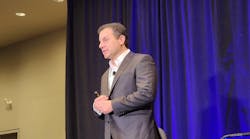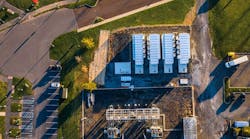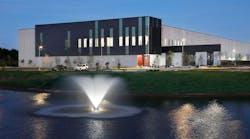People want their Internet, and they want it all the time, wherever they are. And they want it fast, with no buffering on those videos!
But that love of the Internet doesn’t always extend to the generators and other equipment that power the network. In a growing number of communities, data centers are becoming the focus of protests in which residents are upset about the noise and emissions of generators or the presence of power lines in their community.
The impact of NIMBY (Not In My Backyard) on the data center industry has entered a new phase, culminating in a court ruling in Paris this week that revoked the approvals for a working data center operated by Interxion. DataCenterDynamics reports that an administrative court in the Paris suburb of Montreuil has withdrawn Interxion’s license to operate a data center in La Courneuve (apparently PAR7), threatening a facility that cost nearly $150 million to build.
The case was prompted by complaints from a group of residents of a neighborhood near the data center, who complained about the noise and proximity of large diesel storage tanks. Although the project was approved at a public meeting in 2013, the group claimed that the details were poorly communicated and difficult to understand. The court ruling (in French) focused on the noise levels at the facility and whether they had been accurately represented in the initial hearings.
Interxion has two months to appeal. While headlines suggest the data center may be shut down, it’s hard to imagine that as the final outcome. Given the level of investment by an international company, one hopes that a compromise is possible, perhaps through modifications to address noise concerns.
The Paris dispute is the latest in a series of disputes in which local residents have voiced opposition to data center projects or their supporting infrastructure. These cases highlight the need for data center operators to work with local officials and the community to identify and address concerns that may emerge during the development and operation of a major data center.
Expansion strategies must account for the fact that community groups can quickly build online information networks to challenge projects, particularly involving noise, emissions and new power lines.
The Evolution of NIMBY and the Data Center
Complaints from neighbors about data centers are not new, especially in urban areas. As early as 2002, residents in the TriBeCa section of Manhattan voiced complaints about noise and fuel storage at 60 Hudson Street, a major data and telecom hub. In 2010, residents of Quincy, Washington challenged approvals for new diesel generators at a Microsoft data center, but state officials found that diesel emissions presented no healththreat to the community.[clickToTweet tweet=”Complaints from neighbors about data centers are not new, but are becoming more frequent.” quote=”Complaints from neighbors about data centers are not new, but are becoming more frequent.”]
The tenor and intensity of citizen protests changed with a project in Newark, Delaware that was canceled after a local group called Newark Residents Against the Power Plant mounted lengthy and tenacious opposition. The proposed project from The Data Centers LLC included a 279-megawatt cogeneration facility that became the focal point for the protests.
The Newark case has been followed by a number of cases in which neighbors have raised concerns:
- In Haymarket, Virginia, a group called The Coalition to Protect Prince William County has organized to fight the proposed route for power lines from Dominion Power for a large new data center, reportedly for Amazon Web Services. The group is asking Dominion to choose an alternate route and bury its power lines, rather than using towers.
- In Loudoun County, Virginia, residents and the Board of Supervisors have raised questions about the path of a Dominion Power transmission line to support a new data center south of Dulles Airport. As with the Haymarket case, the final decision on a route will be made by a state commission.
- In Chandler, Arizona Salt River Project has temporarily suspended its plans for the 230 kV transmission line to support future growth, citing challenges in securing rights of way from area land owners. A group of residents have opposed the plan, objecting to overhead power transmission towers and urging SRP to bury the lines, which the utility says would be 10 times as expensive. SRP says it will continue to pursue alternative routes to complete the project.
These citizen groups have built a louder megaphone, creating a template for organization that leverages social media, blogs, research and media outreach. This is part of the equation for data center developers approaching a new project, much the same as zoning and tax incentives. That’s why data center developers would do well to adopt communications strategies that work in the social media age.
Strategies for Future Skirmishes
Last year I outlined strategies for data center developers in a post at Data Center Knowledge. It’s a good time to review them. These include:
- A realistic assessment of a project’s potential for controversy.
- A plan for educating local officials and residents about the data center and its components (including on-site power).
- Early outreach to key stakeholders and making executives available for dialogue with the community.
- A “rapid response” capability to address concerns, rumors and media coverage.
- Active social media channels that allow the company to speak directly to constituents and stakeholders.
A particular caution: While data centers love secrecy during the site selection process, the approach to these “codename projects” must also weight the downside of secrecy – namely, its impact on trust with the community. If residents believe that back-room deals are taking place out of the sight of the public, they will be more tenacious in their research and pursuit of information. Credibility matters, and it can be sacrificed if neighbors believe the process is not on the level.
When issues arise, early intervention with residents and local officials is important. One model for this is Loudoun County, Virginia, which is home to more than 60 data centers and more than 9 million square feet of data centers either operating or under development.
Work With Local Officials
When residents expressed concerns about future development, the Board of Supervisors adopted data center design standards that sought to balance the community concerns – including facade improvements and parameters on generator testing – and the needs of the data center industry, which has provided a huge economic boost to the region.
Good planning and effective use of communications tools can ensure that a project gets a fair hearing, and the community has a chance to make a fully informed decision about the proposal.
Most importantly, extend the “belt and suspenders” ethos of data center engineering to the site location process. Always have a backup plan. Even if a project is rejected in one site, it could find new life somewhere else.
An example: Last year Amazon Web Services was seeking locations for data center campuses in Ohio. When residents of Orange Township raised questions about the potential noise from generators, Amazon quickly shifted gears, withdrawing its proposal and pivoting to a site in New Albany, where local officials offered tax incentives.






